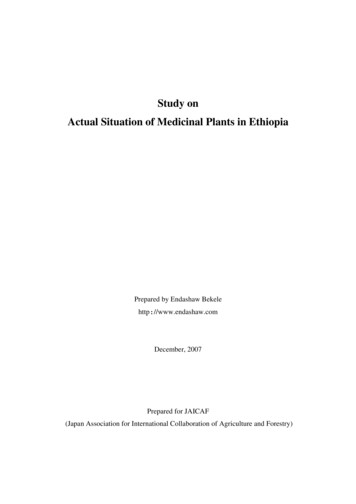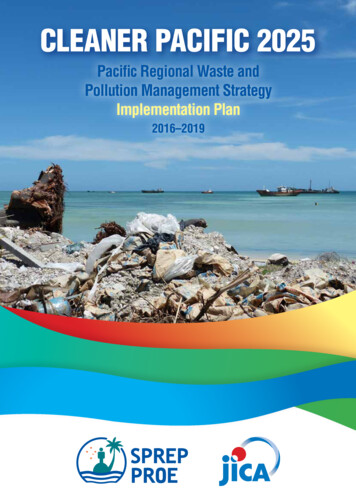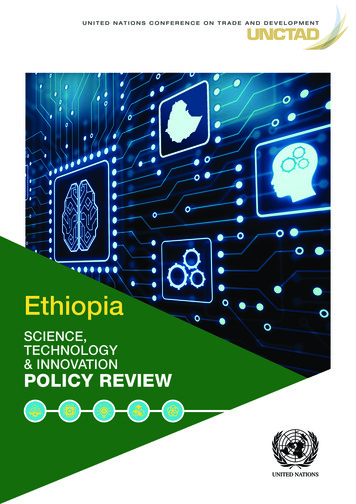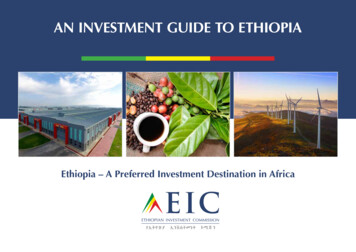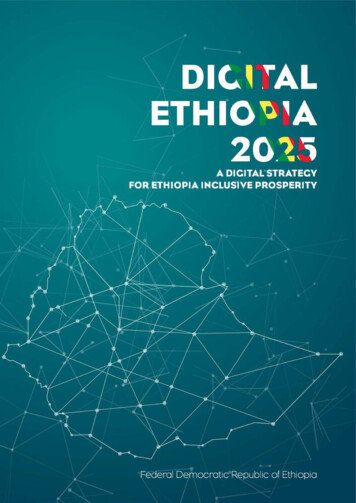
Transcription
DIGITAL ETHIOPIA 2025 -A STRATEGY FOR ETHIOPIA INCLUSIVE PROSPERITYForewordThe world is undergoing a fourth industrial revolution at an unprecedented rate.Ethiopia must proactively embrace it to ensure our communities benefit, and our youthsucceed in the new world. We are witnessing a global transformation driven by new technologiessuch as Artificial Intelligence, Internet of Things, Nanotechnology, and Big Data, amongst many othersthat offer new models for production, communication, and lifestyle. Our children require new skills andknowledge, and it is our responsibility to position them better in seizing the future.Ethiopia is yet to realize its potential in the digital space and leverage technology tobuild a more prosperous society. Urgent, bold, and coordinated action is needed so wecan make this transformation successful. We are on a journey of rapid economic and socialchange. In 2019, we adopted the Homegrown Economic Reform Agenda and the Ten-Year NationalDevelopment Plan (2020-2030). New digital technologies offer an opportunity to sustain growth andensure every citizen benefits from a more prosperous nation.Leveraging these digital opportunities demands a new mindset and leadership stylefrom the Government. Enabling innovation means embracing the unknown. The Governmentcommits to investing in Research and Development of future and emerging technologies as well ascreating an enabling environment for courageous, innovative and committed people to develop newbusinesses, services and jobs.Like many new and mostly unknown opportunities, there are risks to mitigate andlessons to be learnt to ensure our future is safe and inclusive. While these risks includecybersecurity innovation, harmful social media content, a growing gap between the rich and poor, therisks to not leveraging digital technologies, however, are higher for developing economies like ours. TheCovid-19 pandemic, for example, has provided powerful lessons in the importance of digital tools: totrace and track high-risk individuals, to facilitate vaccine research, as well as to mitigate the economicdownturn by safely enabling people to work remotely. Ultimately, the most considerable risk iscomplacency in understanding and navigating our new digital paradigm. Also, informed risk-taking and acompassionate spirit are vital to ensuring gender and socio-economic gaps are bridged and not merelymanaged.Inclusively realizing new opportunities demands learning, collaboration, andpartnerships, both within and beyond Ethiopia. The development of this strategy has beenpossible through cooperation and collaboration amongst various stakeholders, local and internationalleaders. Special thanks to the Ministry of Innovation and Technology, Oxford University's Pathways forProsperity Commission, MasterCard Foundation, Tony Blair Institute, Dalberg, and the United NationsEconomic Commission for Africa. Together we keep learning from each other, we collaborate moredeeply, and we form more robust and more innovative partnerships.Version 4.0II
DIGITAL ETHIOPIA 2025 -A STRATEGY FOR ETHIOPIA INCLUSIVE PROSPERITYThis strategy is a first step and a call to action. Only work brings to life and delivers meaningfulresults to citizens who deserve a prosperous future. This strategy is the first step and fundamentally a callto action. I invite all those committed to a prosperous future for Ethiopia to join together and contributeall they can. I am confident we can do it together.Abiy Ahmed Ali (PhD)Prime MinisterFederal Democratic Republic of EthiopiaVersion 4.0111
DIGITAL ETHIOPIA 2025 -A STRATEGY FOR ETHIOPIA INCLUSIVE PROSPERITYTable of ContentsE·xecutive Summary . 21. Introduction . 82. Vision and Objectives . 123. Framework & Methodology . 174. Dig itall y Enabled Pathways for Pros perity for Ethiopia . 214.1 Ethio ia's Pathwa 1: Unleashin Value from A riculture . 214.1.1 Current Status . 224.1.2 Global Trends. 234.1.3 Where Ethiopia Can Succeed: Opp ortunities. 254.1.4 Ensuring lnclusivity . 274.2 Ethiopia's Pathway 2: The Next Version of Global Value Chains in Manufacturing . 284.2.1 Current Status . 284.2.2 Global Trends. 294.2.3 Where Ethiopia can succeed: Opportunities . 314.2.4 Ensuring lnclusivity . 344.3 Ethio ia's Pathwa 3: Buildin the IT Enabled Services Sector . 354.3.1 Current Status . 354.3.2 Global Trends. 364.3.3. Where Ethiopia can succeed: O pportunities . 374.3.4 Ensuring lnclusivity . 394.4 Ethio ia's Pathwaital as the Driver of Tourism Com etitiveness . 404.4.1 Current Status . 404.4.2 Global Trends. 414.4.3 Where Ethiopia can succeed: Opportunities . 454.4.4 Ensuring lnclusivity . 475. Where Ethio pia is: Assessing Ethiopia's Dig ital Readiness . 485.1 Infrastructure . 485.1.1 Connectivity . 48Version 4.0IV
DIGITAL ETHIOPIA 2025 -A STRATEGY FOR ETHIOPIA INCLUSIVE PROSPERITY5.1.2 Power . 525.2 Enablin S stems. 555.2.1 Digital ID. 555.2.2 Digital payments . 585.2.3 Cybersecurity . 615.3 Di ital Interactions amon Government Private Sector and Citizens . 635.3.1 E-Governance. 635.3.2 E-commerce. 675.4 The Di ital Ecos stem . 705.4.1 Finance . 705.4.2 People . 765.4.3 Policy & Regulation . 816. What needs to be done. 876.1 Short Term Foundational Pro·ects u to 18 months . 876.1.1 Prioritized Projects to unlock the digital economy by strengthening existing infrastructure . 886.1.2 Prioritized Projects to Develop enabling systems that further enhance the digital economy . 956.1.3 Prioritized Projects to facilitate digital interactions among different actors . 976.1.4 Prioritized Projects to Strengthening the Digital Ecosystem . 1036.1.5 Prioritized Projects to enhance Tech Entrepreneurship . 1066.1.6 Prioritized Projects to enhance Digital Payments . 1116.1. 7 Prioritized Projects to enhance E-commerce . 1116.2. Mid Term 3 ears to Lon Term 5 ears Foundational Pro·ects . 1136.2.1 Power Infrastructure. 1136.2.2 Finance . 1157. Summary of the Foundational Projects: Timeframe and Key Stakeholders . . . 1188. Government stakeholders and timeline of all 22 projects and Summary of the Digital Opportunitiesfor Economic Drivers . 1219. Conclusion and suggested success measures . 123ANNEX . 126Annex I: List of Acronyms . 127Version 4.0V
DIGITAL ETHIOPIA 2025 -A STRATEGY FOR ETHIOPIA INCLUSIVE PROSPERITYAnnex II: Country Case Examples . 129Annex Ill: Universal Postal Union Gap Assessment on E-Commerce . 136Annex IV: Bibliography. 143Annex V: Documents and MlnT Directorates consulted to develop the strategy . 148Version 4.0VI
DIGITAL ETHIOPIA 2025 -A STRATEGY FOR ETHIOPIA INCLUSIVE PROSPERITYTable of FiguresFigure 1: The Digital Transformation Journey . 9Figure 2: Definitions of Digital Transformation, Digitalization, and Digitization . 10Figure 3: Key Objectives of the Strategy . 15Figure 4: Pathways Framework and Methodology . 17Figure 5: Digital Economy Framework . 18Figure 6: Stakeholder groups consulted . 19Figure 7: The Four Pathways to take Ethiopia through the Digital Transformation journey . 21Figure 8: Expected average reskilling needs across companies, by share o f employees, 2018-2022 . 30Figure 9: Impact of digital on tourism competitiveness index. 43Figure 10: Role of digital across the tourism value chain . 44Figure 11: Principles on Identification of Sustainable Development; . 57Figure 12: Identity as a platform for development . 58Figure 13: Tax revenue vs. GTP II targets for Ethiopia . 64Figure 14: Current E-Government initiatives deployed by the Government of Ethiopia . 66Figure 15: E-commerce growth in Africa and Ethiopia's standing on E-commerce preparedness index . 68Figure 16: Constraints to doing business in Ethiopia . 71Figure 17: An illustrative life of a Start-up business . 83Figure 18: The process of implementation for an innovation office and sandbox regulatory approaches85Figure 19: Key Imperatives for Digital Readiness. 86Figure 20: Global Internet penetration . 90Figure 21: Internet penetration and broadband subscription growth across Africa . 90Figure 22: Active mobile and fixed broadband subscriptions across major African nations . 91Figure 23: Emerging technology trends in connectivity. 92Figure 24: Building blocks for E-commerce development . 102Figure 25: Growth o f technology start-ups across the world . 108Figure 26: Key success factors from effective incubators across the world . 109Figure 27: Summary for Prioritized Short Term Projects . 113Figure 28: Summary of Mid to Long Term Projects . 117Figure 29: Projects on a timeline and mapped to themes and key stakeholders . 121Figure 30: Major Opportunities created through each pathway and timeline for implementation . 1221Version 2.0
DIGITAL ETHIOPIA 2025 -A STRATEGY FOR ETHIOPIA INCLUSIVE PROSPERITYExecutive SummaryTechnological change has been the primary driver of social development, productivity improvements andinclusive growth. The world is, once again, at the dawn of the next technological change. Countries are atdifferent stages and have different opportunities available to them in this new paradigm. A critical firststep is to ensure the approach selected for digital transformation is treated as a means to a country'snational development vision and priorities.For Ethiopia, a digital transformation strategy needs to be aligned with critical Homegrown documentsi.e. the 2019 Homegrown Economic Reform Agenda and the Ten-Year Development Plan (2020-2030) aswell as with international commitments such as the Sustainable Development Goals and the AfricanUnion's Continental Digital Strategy. These guiding Government documents aim to correctmacroeconomic imbalances, address structural impediments to inclusive prosperity and highlight sectoralpriorities - ultimately to develop an inclusive, knowledge-based and prosperous society. Agriculture,manufacturing, mining, information and communications technologies (ICTs), the creative industry andtourism are the selected sectors that Government has prioritised for job creation, forex and exports, andinclusive growth. While the Government will use such guiding documents and iterative analysis to supportand enable the digital economy, the role of the private sector will be fundamental in harnessing the fullpotential of digital transformation.Strategy Objectives & MethodologyEthiopia's digital economy is at an early stage of development with few private sector players offeringdigital services and some government driven digitalization initiatives. While these initiatives and serviceshelp solve important challenges, they cut across multiple stakeholders and require a coordinated effort tomaximize their impact. This strategy was developed to provide a collective vision and, specifically to meetthe following key objectives:1. To propose an inclusive digital economy approach that will catalyse the realisation of Ethiopia'sbroader development vision.2. To be a visionary umbrella strategy from which sectors and institutions can then design and co-createmore specific action-oriented strategies with relevant budgets, timelines and key performanceindicators.3. To emphasize the need for a sense of urgency4. To mobilize critical stakeholders to address the imperatives that will enable an inclusive digitaleconomy5. To coordinate and strengthen current initiatives underway so the most pragmatic and strategicpathways are explored to unlock growth and maximize impact.6. To ensure an inherently international approach that will enhance Ethiopia's place in regional andglobal value chains while benefitting from best practice and interoperable systems.This strategy was designed using the latest research - in particular from Oxford University's Pathways forProsperity (P4P) Commission, which provided the Digital Economy Tool Kit utilised here.As per the recommendations of the toolkit, a three-step approach was used:Version 4.02
DIGITAL ETHIOPIA 2025 -A STRATEGY FOR ETHIOPIA INCLUSIVE PROSPERITY(i) Diagnostic - a digital economy gap assessment was conducted using a framework of four pillars:infrastructure, enabling systems, applications and the broader ecosystem. Country case studies fromwhich relevant lessons could be identified were conducted. These included global and regional leaderssuch as South Korea, India, China, Kenya, Nigeria and Rwanda.(ii) Dialogue - over 60 stakeholders were engaged through bilateral structured interviews andworkshops.(iii) Strategy - this strategy was then developed utilising insights from both the Diagnostic and Dialoguesteps.Leveraging Digitally Enabled Pathways for Inclusive National ProsperityThis strategy took into consideration the current economic drivers (Agriculture, Manufacturing andServices), the priority sectors, and the national objectives of jobs creation, forex earnings and inclusiveprosperity as a means of identifying the most relevant digital enabled pathways for Ethiopia. These are:Pathway 1: Unleashing value from agriculture,Pathway 2: The next version of global value chains in manufacturingPathway 3: Building the IT enabled services, andPathway 4: Digital as the driver of tourism competitiveness.Pathway 1: Agriculture accounts for 45% of the GDP, 85% of the country's workforce,and 90% of export revenue. There are different agriculture technology initiatives; but the key onesare led by ATA and its partners. Globally, technologies such as Internet of Things (loT) and Blockchainsupport the agricultural sector. loT allows farmers to monitor their production and its use is growing atonly 30% per year in Africa due to devices being expensive whereas, blockchain allows Fair Trade labels,traceability, and better (cheaper) payment mechanisms to be implemented. Two specificopportunities identified for Ethiopia to succeed on this pathway are; building a DigitalAgriculture platform; an integrated system that offers new insights that enhance the ability to makedecisions and subsequently implement them, and supporting and incentivizing Ag-techentrepreneurship as these will ensure innovations, jobs, export in agriculture and related sectors, andinclusivity within the thriving Ag-tech entrepreneurship sector in Ethiopia.Pathway 2: Manufacturing has been Ethiopia's fastest growing sector over the past fewyears with a special focus on apparel production. Apparel production has been prioritized as ithas supported economic growth in countries like China, Bangladesh and Vietnam. With this special focusEthiopia is now becoming a new destination for global apparel production. Despite the Fourth IndustrialRevolution (41R) introducing robotic technologies, job opportunities in light manufacturing will continueto exist for some time yet due to the dexterous nature of the work. However, significant advancementsare expected in communication technologies fundamentally changing how information is exchangedincluding how buyers make decisions and orders, and how staff is managed across borders. Currently,apparel factories in Ethiopia are not technologically behind as investors in the latestEthiopian industrial parks arrived with new technologies. Two specific opportunities identified forEthiopia to succeed on this pathway are; enabling the adoption and creation of newVersion 4.03
DIGITAL ETHIOPIA 2025 -A STRATEGY FOR ETHIOPIA INCLUSIVE PROSPERITYcommunication technologies in industrial parks to expand access to global markets and enhancingdigitally enabled logistics management approaches to boost export.Pathway 3: IT- enabled services are those that are not directly IT related but merely performed viainformation technology infrastructure. In Ethiopia, export of IT-enabled services is a small sectorwith only four firms providing such services. Infrastructure is the most binding constraint.Globally, online labour is growing at 26% per year with developing economies leading supply while moredeveloped ones dominate the demand side. Two specific opportunities identified for Ethiopia to succeedon this pathway are; providing infrastructure to high potential talent centres and reframingand operationalizing the IT Park to attract leading Business Process Outsourcing (BPO),specifically Impact Sourcing Service Providers (ISSPs) which are often non-profit, or semi-for profit organizations with particular social business angles of targeting workers from underprivilegedcommunities.Pathway 4: Leisure and business tourism helped the Ethiopian tourism industry to expandrapidly at a rate of 1396 annually since 2007, faster than the 7.3% annual average growth forSub-Saharan Africa. However, challenges such as lack of quality Internet connectivity and poormanagement of tourism data restrict the growth of the sector. Globally, tourism GDP hasgrown at 4% annually, outpacing global economic growth at 3.2% and has made a significant contributionto socio-economic development. Ethiopia can take lessons from South Africa, Thailand, and Kenya thatused digital technologies to unleash their tourism sectors. Three specific opportunities identified forEthiopia to succeed on this pathway are; driving digitalization across the tourism industry bysetting up a tourism digitalization task force, improving tourist inflow and increasing touristactivity through targeted digital marketing strategies, and building capacity of tourism SM Es toadopt digital technologies (including improving online presence and accepting digital payments).Accessing Ethiopia's Readiness for Digital TransformationEthiopia's digital readiness can be enhanced by strengthening existing infrastructure; developing enablingsystems; facilitating digital interactions between government, private sector and citizens; andstrengthening the wider ecosystem - in particular, access to capital investment, human capital and theregulatory environment.InfrastructureConnectivity: Internet coverage has grown at an annual rate of 45%, which is slower than peer nations.Ethiopia has also evidenced a significant growth in mobile subscriptions with the proportion reaching 60%in 2017 (with 41% active subscription), but again, mobile adoption is still low compared to peer nations. Asimilar pattern can be observed for broadband access where active mobile broadband subscriptions standa t 7.1%, compared to an average 24.8% in the region. Key challenges identified are gaps acrossnetwork coverage, affordability and quality. Current Initiatives to resolve these challenges includesectoral reforms in the telecom sector led by the Ethiopian Communication Authority (ECA), and theMinistry of Innovation and Technology (MlnT) 's work to upgrade and modernize the WoredaNet as wellas improve bandwidth ca pacity. Recommendations to address critical gaps in connectivity is to have aVersion 4.04
DIGITAL ETHIOPIA 2025 -A STRATEGY FOR ETHIOPIA INCLUSIVE PROSPERITYcomprehensive telecom roadmap and robust regulations that can ensure accelerated progress towardsthe national objectives, to upgrade the WoredaNet by doing a detailed supply and demand side planningto improve institutional connectivity, and to set up and operationalize a universal service fund to expandinfrastructure/ connectivity.Power: Electricity access to households is 44% - on par with Sub-Saharan Africa (44.5%); with 50%connecting off-grid and major differences between urban {96%) and rural areas (31%). Key challengesfor Ethiopia is the unreliability of power supply, and the financial unsustainability of the current highlysubsidized tariffs. Current initiatives to resolve these challenges include a Public Private Partnership(PPP) proclamation and reform of power generation procurement, Ethiopian Electric Utility restructuringand corporatization, implementation of the electrification strategy (National Electrification Plan (NEP)2.0), and transmission network expansion. Recommendations to address critical gaps in power areinvesting in last mile connection upgrade, diversification of energy sources and off-grid solutions,establish a targeted subsidies scheme, and facilitate follow up and maintenance through measurementand monitoring systems.Enabling systemsDigital ID: The most important form of identification is the Kebele ID card that is issued by localadministrators in more than 18,000 administrative locations. In many ways, it functions as the de factonational ID yet there is no central registry, no way to ensure uniqueness, and an extremely weakcredential that can easily be forged. It thus limits usefulness for a digital economy as one individual mighthave more than one Kebele ID. Key challenge identified for efforts put to introduce a Digital ID are lackof coordination and communication among authorities resulting in individuals having different "uniquenumbers" for different programs which defeats the purpose of having a Digital ID. Current initiativesto introduce a National Digital ID program envisioned to replace the Kebele ID system is led by theMinistry of Peace. This Ministry is setting the strategy by engaging different stakeholders including MlnT.Our key recommendation is to adopt the ten Principles on Identification for Sustainable Developmentdrawn around Inclusion, Design and Governance. These Principles have now been endorsed by over 25international organizations, donors, NGOs, and private sector associations.Digital payment: In 2018, 12% of Ethiopians made or received digital payments, 4% hold debit cardsand 0.3% (foreigners and diaspora) holds credit cards, as no bank in Ethiopia offers a credit card. Keychallenges in this area is low internet penetration, high data costs, low mobile penetration, low accessto formal financial services (banked population is 35%), lack of awareness of existing digital financialservices and a fintech industry that is just beginning due to regulation constraints. The lack ofinteroperability among banks and financial services, as well as wallets, significantly hampers growthincluding entry of players for mobile money and innovation in financial solutions. Current Initiativesinclude reforms in the regulatory environment; the National Bank of Ethiopia (NBE) amended the BankingServices Proclamation to include Digital Financial Service Providers and it has recently released two draftdirectives namely a Payment instrument issuers Directive and an Agent Directive. In addition MlnT hasfinalized the draft of a comprehensive all-in-one E -Transaction Proclamation. Recommendations toaddress critical gaps in digital payment are ensuring financial inclusion by promoting current financialVersion 4.05
DIGITAL ETHIOPIA 2025 -A STRATEGY FOR ETHIOPIA INCLUSIVE PROSPERITYservices and evaluating the adoption of inno
5. To coordinate and strengthen current initiatives underway so the most pragmatic and strategic pathways are explored to unlock growth and maximize impact. 6. To ensure an inherently international approach that will enhance Ethiopia's place in regional and global value chains while benefitting from best practice and interoperable systems.



